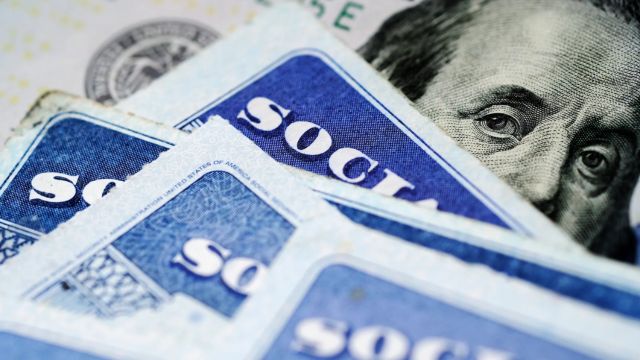MJP –
Millions of retired Americans will see a boost in their Social Security payments this month, with a 2.5% cost-of-living adjustment. But that’s not the only surprise—some recipients might receive two checks in November.
Typically, Supplemental Security Income (SSI) payments arrive on the first of each month. However, due to a timing rule, December’s SSI check will be issued early, landing in mailboxes on November 29. This happens when the first of the month falls on a weekend or holiday, prompting payments to arrive on the prior business day.
The quirk doesn’t end in November. This schedule will affect payments through March. January’s check will arrive on December 31, February’s on January 31, and March’s on February 28.

Social Security recipients are in for a pleasant surprise this month with double checks arriving alongside bigger payments. If you’re one of the millions of Americans who rely on Social Security benefits, you may notice a larger-than-usual deposit in your account in the coming days. But what’s behind this increase, and why are some beneficiaries getting two payments instead of one?
Here’s everything you need to know about the double checks and why the payments are larger this month.
Why Are Social Security Beneficiaries Receiving Double Checks?
For some Social Security recipients, this month’s payments will arrive in two installments instead of the usual one. This happens because of a quirk in the Social Security payment schedule combined with the timing of certain holidays and administrative adjustments.
2025 Brings a 2.5% Boost in Social Security Benefits for Millions
Typically, Social Security benefits are paid monthly, based on the date you were born and your chosen payment schedule. However, when the payment date falls on a weekend or a federal holiday, payments are often made on the preceding business day. This can lead to a situation where one month’s payment is delayed or adjusted to the next month.
In December 2024, the regular Social Security check for certain recipients falls on the 1st, which is a Sunday. Because of this, the payment is moved to the last weekday of the previous month—November 29th. To compensate for this shift, beneficiaries will receive their usual payment in early December (on the 1st, or a nearby business day), plus an additional check that corresponds to the delayed payment for the previous month. This creates a situation where some beneficiaries will see two checks in their account for the month.
What About the Larger Payments?
In addition to the double payment, many Social Security recipients will also see larger amounts than usual this month due to the annual cost-of-living adjustment (COLA) increase. For 2024, the Social Security Administration (SSA) has announced a 3.2% COLA increase to help offset the rising cost of living. This adjustment is applied to both Social Security retirement benefits and Supplemental Security Income (SSI) payments, giving recipients a little extra purchasing power as inflation continues to impact everyday expenses.
Breaking: Social Security Payments Confirmed for Illegal Immigrants in Early November
For example, if you were receiving $1,500 per month in Social Security benefits prior to the COLA adjustment, your payment for December (and beyond) would increase by $48, bringing your total monthly check to $1,548. The COLA adjustment is automatically factored into the double payment that recipients will see in their accounts this month, making the combined check even larger.
Who Will Get Double Payments?
Not all Social Security recipients will get double checks. Typically, this arrangement affects people who receive benefits on the 1st, 2nd, or 3rd Wednesday of the month. For example:
- If you receive benefits on the 1st Wednesday of the month, your payment will be adjusted to the last business day of November, and you will also get your regular payment in December.
- Similarly, 2nd Wednesday recipients may get double checks for December, with one payment for the end of November and the other for their December benefit.
The exact dates depend on your specific payment schedule, which is based on your birth date.
How Will This Impact My Bank Account?
The double payment will appear as two separate deposits, but with the COLA increase applied to both. This means you’ll likely see the larger-than-usual payments reflected in your bank account within days of one another. Whether you receive your payments through direct deposit or by mail, the checks will be delivered separately, although they correspond to the same month.
If you receive both payments, it’s essential to keep track of the total amount to ensure you understand the impact of the COLA increase on your financial situation. Remember that while the extra payment might feel like a windfall, it’s simply a scheduling adjustment.
Will This Be the Same Next Month?
While this month’s double payments are tied to the unique scheduling of Social Security payment dates, next month’s payments should return to the regular schedule. However, the larger payment amounts will continue to reflect the 3.2% COLA increase throughout 2024, so you can expect those increases to carry on for the remainder of the year.
Conclusion
If you’re a Social Security recipient, this month’s double checks and larger-than-usual payments are likely a welcome boost to your budget. The extra payments are due to a combination of the timing of payment dates, the COLA adjustment, and holiday schedules. While these payments might not happen every month, the good news is that your monthly checks for the rest of the year will continue to reflect a higher amount thanks to the COLA increase.
For those who rely on Social Security to cover essential expenses, these extra payments and adjustments can provide much-needed financial relief—especially as inflation continues to affect prices across the country. Keep an eye on your account for those double checks, and enjoy the larger deposit as a result of the annual COLA boost.




